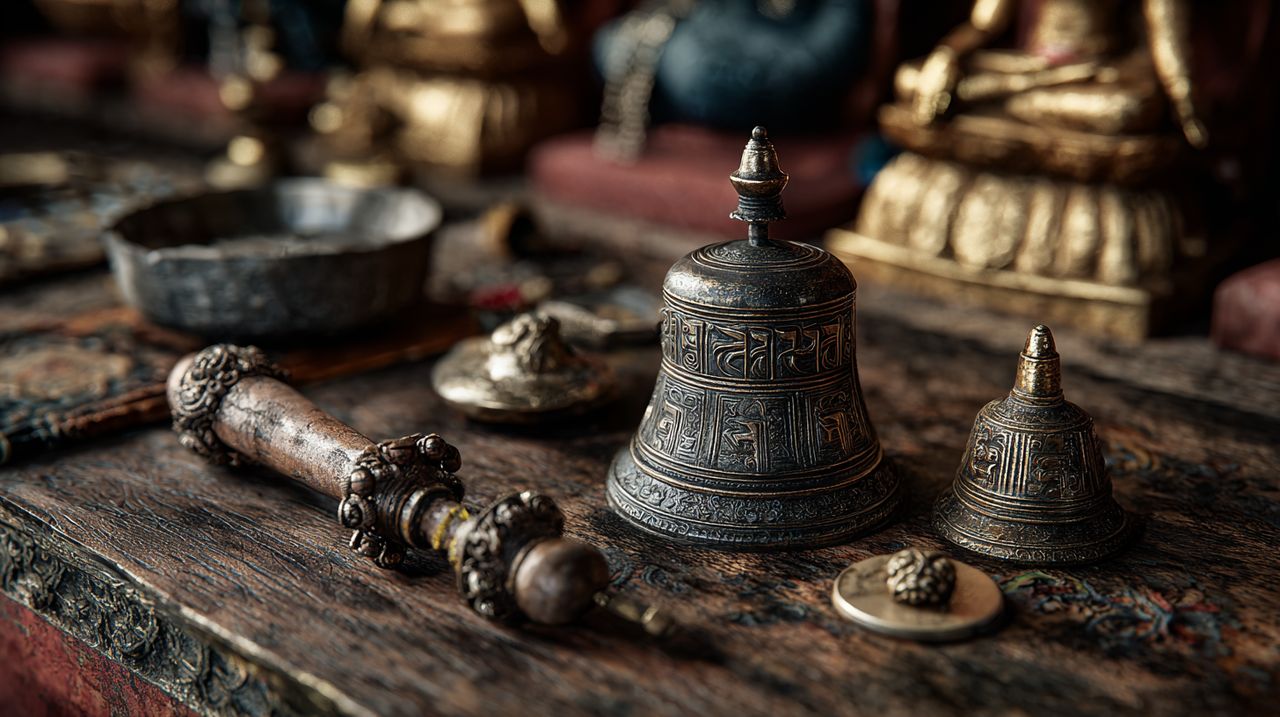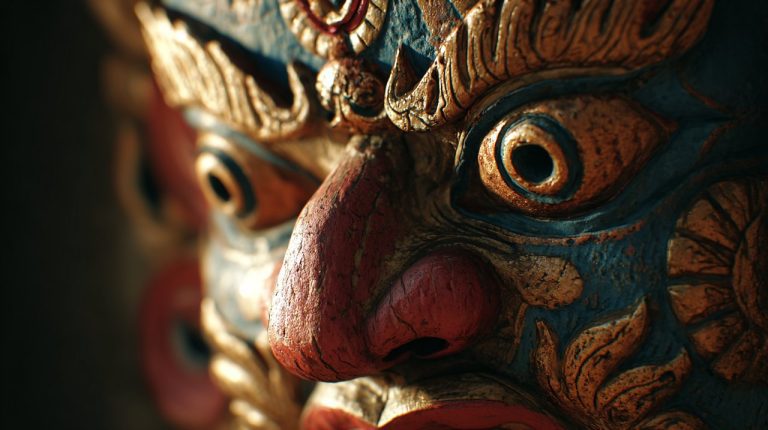The Whispers of Wisdom: Tibetan Instruments as Spiritual Conduits
Picture the crisp dawn air in the Himalayas, carrying vibrations that hint at ancient wisdom. What if these subtle frequencies offered a direct path to deeper understanding, a connection to the very essence of existence? Tibetan tradition views sound not merely as auditory experience, but as a living force, meticulously crafted to guide spiritual awakening. This philosophy is fundamental to their spiritual landscape, distinguishing it significantly from other practices.
Sacred Sound in Tibetan Tradition
In Tibetan culture, sound is a primary, shaping force, much like wind sculpts mountains or water smooths pebbles. This perspective is deeply rooted in their spiritual landscape and Buddhist teachings. Understanding the core tenets of Buddhism can illuminate how these instruments function within a broader spiritual framework. أصول البوذية وتعاليمها الأساسية وممارساتها: شرح شامل

The instruments crafted are deliberate vessels, each designed to carry sacred vibrations that awaken the spirit.
Philosophy of Tibetan Sound
Unlike Western musical traditions often focused on melody, Tibetan sacred sound prioritizes something more fundamental. It centers on resonance, the pure intention behind it, and its energetic impact. The goal is transformation, not entertainment.
The aim is not to entertain, but to transform, to shift something within us. These instruments create an inner space where spiritual growth can begin.
Like prayer flags carrying aspirations on the wind, these instruments engage our senses. They foster an environment for inner development, much like a seed unfurling in fertile ground.
Instruments in Ritual: A Taxonomy
The world of Tibetan instruments reveals a remarkable diversity. Each instrument possesses a unique voice and purpose, reflecting a deliberate design.
These tools are essential for specific rituals, meditations, and healing practices. They serve as trusted companions on the path of Vajrayana Buddhism, guiding practitioners through various spiritual journeys.
Percussion: Bells, Drums, and Cymbals

- The ghanta (bell) and dorje (vajra) symbolize wisdom and compassion. Often paired, they represent the harmonious union of these two essential qualities in practice.
- The damaru, a small hand drum, embodies the constant flow of life. Its rhythmic shake serves as a potent reminder of impermanence and the sudden awakening of spirit. In tantric rituals, the sound of the damaru can help practitioners confront attachments, fostering a direct experience of non-duality. This makes the damaru’s role in meditation particularly impactful.
- Tingsha, small cymbals, produce a clear, lingering tone when struck. This sound is believed to purify space and gently gather a scattered mind, creating an environment conducive to meditation. Their resonant tones are often used to mark the beginning or end of a meditative session.
Many of these instruments are not only ritual tools but also inspire designs in various forms of tibetan jewelry, reflecting their cultural significance.
Wind Instruments: Horns and Flutes
- The dungchen, a long ceremonial horn, produces deep, resonant tones. These sounds travel for miles, calling communities for gatherings or marking important ritual moments. Its voice is often compared to the deep roar of a mountain, echoing through valleys.
- The kangling, traditionally made from a human thighbone, emits a piercing, haunting sound. Used in tantric practices, its purpose is not to frighten, but to guide practitioners in confronting their deepest fears and the illusions of ego. This confrontation leads to liberation, much like facing one’s own reflection in a still mountain lake reveals truth.
Resonant Bowls and Implements
- Tibetan singing bowls, crafted from blended metals, create complex overtones when struck or circled. Their vibrational qualities offer significant therapeutic benefits, facilitating meditation, relaxation, and spiritual healing. The healing effects of Tibetan singing bowls are widely sought for their ability to soothe the mind and body.
- Other implements, such as the drilbu (a handbell), contribute their distinct voices. These instruments are often used in conjunction with mala beads during focused meditation practices, creating a holistic experience.
Ritual and Practice: The Sacred Symphony
Tibetan instruments are integral to a holistic spiritual practice, where chanting, sound healing, and meditation often intertwine. Each element supports and enhances the others, creating a powerful, integrated experience.
Chanting and Mantra: The Voice of Dharma
Combining the human voice with these instruments creates a powerful synergy. Many instruments accompany ritualistic chanting and mantra recitations. The rhythmic pulse of a damaru or the clear ring of a ghanta provides a focal point.
This focus helps practitioners maintain concentration and immerse themselves fully. It allows a deeper immersion into the present moment, amplifying the spiritual current of the practice, much like the persistent rhythm of ocean waves.
Sound Healing: Harmonizing Body and Spirit
The therapeutic qualities of these instruments, especially singing bowls, are widely recognized. Their unique frequencies are believed to promote deep relaxation, reduce stress, and restore energetic balance. This harmonizing effect brings peace to the mind and body, akin to quiet rain nourishing a parched landscape.

Many find them useful for aligning the subtle energy centers, fostering a holistic sense of well-being. This connection to wellbeing is often sought through various forms of tibetan healing bracelet, which aim to maintain positive energy fields.
Meditation and Mindfulness: Aids to Inner Journeys
For those seeking stillness in meditation, the sounds of these instruments serve as powerful anchors. A sustained tone from a singing bowl or the gentle chime of tingshas can quiet a restless mind. This provides an auditory pathway to mindfulness, grounding practitioners firmly in the present moment.
Such focus allows individuals to attain deeper states of inner peace, much like observing a single leaf falling slowly to the ground facilitates calm.
Symbolism and Transformation
Symbolism and Spiritual Connection
Each Tibetan instrument carries layers of symbolic meaning, reflecting core Buddhist principles and the path to enlightenment. They serve as tangible manifestations of spiritual truths.
Like a steadfast mountain peak offering expansive views, many instruments symbolize an awakened mind or divine qualities. The ghanta (bell) represents wisdom, while the dorje signifies skillful means and compassion. Their combined use embodies the perfect union of these qualities on the path to Buddhahood.
The sounds they produce are believed to awaken spiritual energies and purify the surrounding space, creating a sacred environment for practice. This concept of protection and spiritual purity is also seen in practices involving evil eye protection jewelry, which safeguards against negative influences.
Instruments as Vehicles for Transformation
Engaging with these instruments, through playing or listening, is a spiritual practice. It is a journey from the chaos of a bustling forest to the quiet, clear tones of a hidden spring.
These pure, resonant sounds gently guide individuals towards inner peace and realization. This active participation mirrors Vajrayana Buddhist wisdom, where every deliberate action and quiet moment can become a step towards awakening.
The Resonance of Tibetan Wisdom
From the deep call of the dungchen to the healing hum of Tibetan singing bowls, these instruments provide a unique gateway to an ancient spiritual tradition. They are more than objects; they are living traditions, embodying philosophical principles and serving as conduits for ritual, healing, and contemplation.
Like the enduring mountains, their sacred uses and spiritual significance inspire and transform. They invite us to listen, to experience their harmony, and to allow their subtle power to resonate within our own journey. This journey often mirrors the perseverance symbolized by the koi fish symbolism, representing strength and determination in spiritual pursuit.
The harmony of these instruments offers a direct invitation: to listen not just with our ears, but with our entire being, and find the stillness that transforms.
💡 الأسئلة المتكررة
Tibetan sacred sound instruments are viewed not just as tools for melody but as fundamental, shaping forces and deliberate vessels for spiritual vibrations. Unlike Western traditions that might focus on surface beauty, Tibetan sound centers on resonance, pure intention, and energetic impact, aiming for inner transformation rather than entertainment. Their purpose is to create a profound inner space for spiritual growth.
Percussive instruments mark ritualistic beats and shifts in focus. The ghanta (bell) and dorje (vajra) pair symbolize wisdom and compassion working in harmony. The damaru, a hand drum, signifies life's constant flow and impermanence. Tingsha, small cymbals, purify space and gather a scattered mind with their clear, lingering tones.
Wind instruments carry far and wide. The dungchen, a long ceremonial horn, produces deep, resonant tones to call communities together or mark significant moments, akin to a mountain's roar. The kangling, made from a human thighbone, has a piercing sound used in tantric practices to help confront fears and ego illusions, like facing one's reflection.
Tibetan singing bowls, often made from metal blends, produce complex overtones when struck or circled. Their vibrational qualities are profoundly therapeutic, promoting deep relaxation, reducing stress, and restoring energetic balance. They are used as anchors for meditation, quieting the mind and grounding practitioners in the present moment, fostering holistic well-being.
When combined with the human voice, instruments create synergy for chanting and mantra recitations, providing a focal point for concentration and immersion. Their frequencies are recognized for sound healing, harmonizing the body's energy. For meditation, their sustained tones act as anchors, quieting the restless mind and facilitating deeper states of inner peace and mindfulness.








